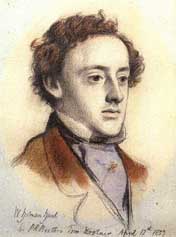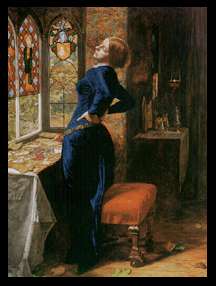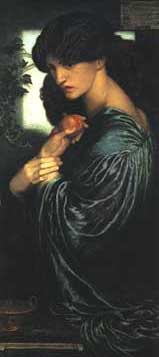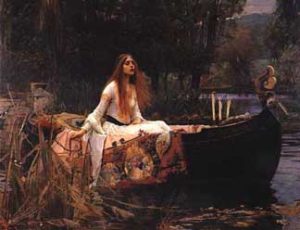The Back Room
The Pre-Raphaelite Mystique
Introduction from the Director of TISA
Deeply tucked away in the elusive corset of the Victorian social fabric, the art of the Pre-Raphaelite Brotherhood lay hidden and alluring. This “brotherhood” was a collection of seven artists, Dante Gabriel Rossetti, John Everett Millais, William Holman Hunt, James Collinson, F. G. Stephens, Thomas Woolner, and William Rossetti (Dante Gabriel Rossetti’s brother). By mid-Victorian times some of the artists of the Pre-Raphaelite Brotherhood, and several new artists associated with the movement, had become well known, albeit quite controversial. By late Victorian times a few of the Pre-Raphaelite artists had gone surprisingly “main-stream”, seemingly “sold-out” to the same commercial interests that shanghaied the Victorian Christmas into a commercial bonanza for the department stores of Fifth Avenue. And by the closing of Victorian times, as the trenches of World War I waited in the future for an unwary Europe, the artists of the Pre-Raphaelite Brotherhood and their works had quietly settled into the dust of obscurity.
Their subtly sensual art is a delightful respite for modern eyes grown weary from a rather constant bombardment of not so subtle images of sensuality. Although their more mundane works are indeed dated, their finest paintings are laced with a vivid palette and a haunting atmosphere. This, the first “Back Room” of TISA is a brief introduction to their fascinating lives and works. If you like what you see, we have attempted to provide both a listing of recommended readings and a set of links to some of the finest sites on the web devoted to their art, just waiting for your click. Enjoy.
The Players



The official brotherhood was short-lived remaining intact for only a handful of years from 1848 to 1853. It’s happenings were carefully inscribed in the journal writings of William Rossetti, who proved to be more of a historian than an artist within the group. The intensity of their bond was nicely captured by William in this entry:

by John Everett Millais
(W. M. Rossetti, Dante Gabriel Rossetti: His Family Letters, 1895)
Before the group disbanded they managed to publish a few editions of a rather radical journal The Germ, that would prove to be the rage of the artistic underground. More importantly they had created some true masterpieces of Western Art, some of which appear on this site.
Although the list of players described above is exclusively male, the Pre-Raphaelite world was strongly influenced by women. At a more basic level the mistresses and models – known as “stunners” to the Pre-Raphaelite clique were important sources of visual imagery and even helped to define the Pre-Raphaelite sense of beauty. But equally powerful were the keen intelligences and artistic abilities of the talented women associated with the movement including one of the most revered of Victorian poets, Christina Rossetti, Dante Gabriel Rossetti’s sister. Other talented women included the artist and poet Elizabeth Siddal, who chose Rossetti to be her husband, and the gifted painters Kate Bunce, Evelyn De Morgan, Marie Spartali Stillman, and Eleanor Fortescue Brickdale.
The Play

by John Everett Millais
The cover painting for our Back Room, “Autumn Leaves” by John Everett Millais, demonstrates Pre-Raphaelite work at its best in my opinion. In this richly evocative painting we come upon four Autumn waifs lost in their work and their reveries. Are they sisters? Friends? No one knows. Are they enjoying themselves? Unhappy? No one knows. But we do sense that they are intensely involved in their own little worlds, whatever they may be. Something important is happening.
In particular, the small girl in the forefront, holding the apple, seems lost in reverie. She is a fascinating example of the “detail work” of Pre-Raphaelites, a detailed emphasis on the outer world that sometimes points, paradoxically, towards the inner world. Note the bite out of her apple, and the fact that she has a slightly askew “wall-eye” that has wandered to the right. These touches of real humanness – simple appetite and birth damage – make her at once more real and curious. Most importantly she is not perfect, like a cute little girl should be, if painted by correct academic standards. One can almost hear a nonplussed Victorian critic thinking, “This is a wonderfully wrought painting, but my God, why did he choose to show her wall-eye? It could have been painted out so easily”.
We also see here another aspect of the richness of “truth to nature” as shown by the virtuoso rendering of the leaves in the leaf pile. The technique of Millais would look almost more at home in a display of modern “hyperrealism” than on the walls of the Royal Academy. To boot, the colors have a deep and warm feeling, very atypical of the somber palette of much of academic art. All of these touches would have made this painting potentially jarring to the Victorian eye, especially an academic one.
We also see here an example of a whispered symbolism, as opposed to a potentially more hackneyed literal approach. The painting is, indeed, supposed to mean something. Millais stated as much. Apparently, for Millais, the intent was to provoke a quietly religious reference to the inevitability of death as symbolized by Autumn and the falling away of leaves to decay. Perhaps this feeling, almost of wonderment, is the focus of the little girl’s inward gaze as she pauses from munching on her apple.
In any case the painting captures Autumn as well as any painting I’ve ever seen. Like a great painting can do, it adds something intangible, that a photograph could not do, for what it captures is not in the scene but in the head of the artist, where no camera lens may peek. “Autumn Leaves” is Pre-Raphaelite work at its best. Interestingly, this painting by John Everett Millais was one of Dante Gabriel Rossetti’s most favorite paintings.
The Reviews
Mixed. As one would expect, much of the criticism in the early years was hostile, sometimes vehemently so. More realistic renderings of human faces and bodies was bad enough with everyday people, but when the Pre-Raphaelites took this approach to religious figures like Mary and Christ as Millais did in his painting “Christ in the House of His Parents”, enough was enough. Charles Dickens nearly flipped out, denouncing this painting as truly, “commonplace and irrelevant”. In its day this comment would be like Steven Spielberg calling your movie a “pile of crap”. It did not bode well for the brotherhood, despite the fact that many critics had liked some of their work, especially the unmistakably gifted draftsmanship of the outlandishly precocious Millais.

Dante Gabriel Rossetti
On a more personal note, Ruskin’s opinion of John Everett Millais dampened down just a tad after Ruskin’s wife had their marriage annulled – apparently Ruskin had not consummated the marriage – so that she could marry Millais, with whom she proceeded to have six children. Her new Pre-Raphaelite husband apparently had no problem consummating marriages.
Nevertheless Ruskin would prove to be right with regard to the enduring influence of the Pre-Raphaelites, although their true place of importance has been long in receiving its rightful recognition. Even to the modern eye, as hopefully this site shows, some of these paintings are simply gorgeous.

by Sidney Harold Meteyard

by Eleanore Fortescue Brickdale
An equally powerful line of influence was the popularity of Rossetti and Burne Jones with European Symbolists, especially in France. In part, these Symbolists, in their own right, would influence the early phases of the abstract art movement in its search for spiritual meaning in abstract form. Thus it can be seen that the Pre-Raphaelites were one of the first of the 19 century artists to emphasize the importance of art as true decorative space. Ironically, despite their emphasis on truth to nature, they helped set the foreground for modern art. In the wake of the Pre-Raphaelite mystique, painters felt they could more openly break the limiting rules of the Royal Academy. Artists began to experiment more daringly with curving lines and luscious colors – aspects still of prime importance in contemporary art from the dustjackets on our books to the images on our websites.
The Denouement
Here at TISA we hope that you have enjoyed your visit to our first “Back Room” and the world of the Pre-Raphaelite Brotherhood. I think you will find that both the art and the lives of these artists are endlessly fascinating. The relationships and intrigues among themselves and the world of Chelsea, London, are rather extraordinary. For more information on the Pre-Raphaelites I highly recommend The Pre-Raphaelites by Christopher Wood, Pre-Raphaelites in Love by Gay Daly, and just about anything that Jan Marsh has written. Below are some great starting points, from both Marsh and others:
- Wood, Christopher: The Pre-Raphaelites , (Hardbound. Great color illustrations and highly readable text. My favorite general introduction to the Pre- Raphaelites, and it is sometimes on sale. Alas, it is also out of print but Amazon.com could probably find it for you surprisingly quickly.)
- Hardin, Terri: The Pre-Raphaelites, Inspiration from the Past. Todtri Productions Limited, New York, 1996. (Hardbound. Another lovely introduction with great color illustrations. Also often in the sale bin and still very much in print.)
- Daly, Gay: Pre-Raphaelites in Love. Ticknor & Fields, New York, 1989. (Hardbound. Absolutely fascinating account of the entwined lives of these artists. Who needs soap operas, with these guys around. A compelling read. Best book on their lives. Not where you would look for good illustrations of their works.)
- Marsh, Jan: Pre-Raphaelite Women, Images of Femininity. Harmony Books, New York, 1987.(Hardbound. Fascinating book with excellent color illustrations. Marsh is the undisputed leader in bringing insight onto the powerful women who were important elements in the development of the Pre-Raphaelite influence.)
- Marsh, J. and Nunn, P. G.: Pre-Raphaelite Women Artists. Thames and Hudson, London, 1998. (Another intriguing book by Marsh that sheds new light on some inappropriately neglected artists. Unusually high quality color illustrations of works you may never see anywhere else. Great book.)
- Marsh, Jan: The Pre-Raphaelites, their Lives in Letters and Diaries. Collins & Brown, London, 1996.(Hardbound. Once you are hooked on the Pre- Raphaelites here is the place to go. Absolute gem. Personal look at their lives through their own writings and paintings, framed by a riveting ongoing narrative by Marsh. Great fun for the connoisseur.)
- Prettejohn, Elizabeth: Rossetti and his Circle. Stewart, Tabori, and Chang, New York, 1997 (Paperback. Wonderful color illustrations especially for a paperback. Unusually well written. Prettejohn makes some insights and observations not often made in typical books on the Pre-Raphaelites. One of my favorite books on the subject and probably the best paperback out there)
- Hilton, Timothy: The Pre-Raphaelites. Thames & Hudson, London 1985. (Paperback. Reasonable illustrations for a paperback, but many are only in black and white, but there is a sprinkling of color too. But the reason to buy is the well written and absorbing text, which is an excellent introduction to the world of the Pre-Raphaelites at a great price. If you don’t have a lot of money, this is an excellent place to begin.)
- Faxon, Alicia Craig: Dante Gabriel Rossetti. Abbeville Press, New York, 1989. (Hardbound. Wow. A magnificent book. Costly, but packed with gorgeous color reproductions of Rossetti’s paintings. If you love Rossetti, here is the book for you.)
Please let us know what you thought of our first Back Room at TISA via Email. Thanks for joining us.
“Omnia exuent in mysterium”





